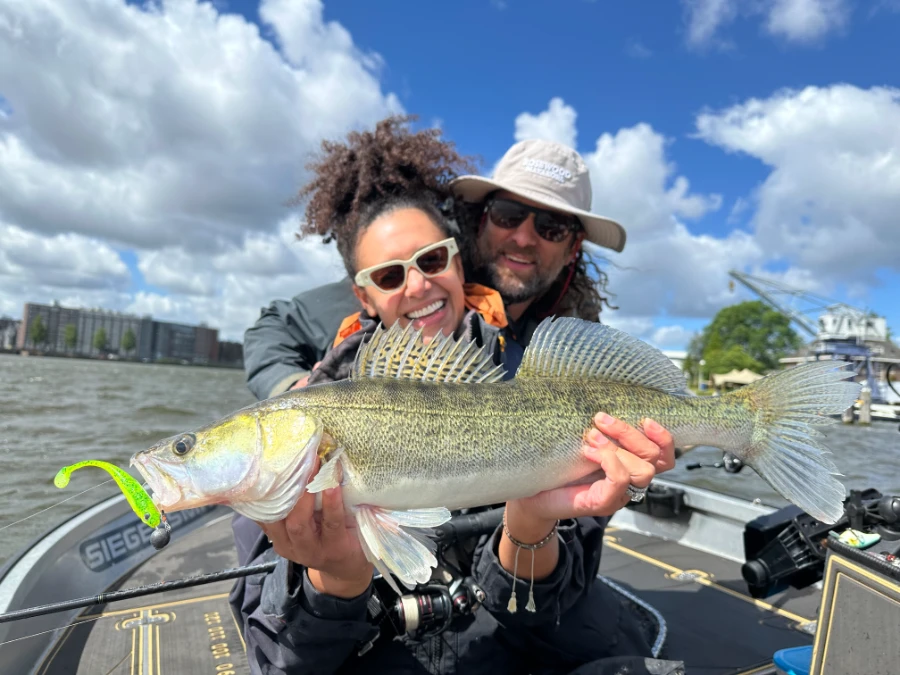After years of guiding anglers through the waters of Amsterdam, Juul has noticed one thing again and again: American guests are always curious about the zander (Sander lucioperca) — the European cousin of their beloved walleye (Sander vitreus). In this article, your guide dives into the key differences (and surprising similarities) between these two iconic predators that continue to captivate anglers on both sides of the Atlantic.
Text and photography: Juul Steyn
Shape & Color
While zander and walleye are biologically closely related and share a similar overall body shape, there are some clear differences in their appearance.
Zander typically have a sleeker, more elongated body with a slightly more pointed head and longer snout.
Their coloration tends to be more silver-grey with dark vertical bars along the flanks, giving them a more defined and “striped” look — especially in younger fish.
Walleye, on the other hand, often have a chunkier build, a rounder head, and a golden-olive coloration with mottled, blotchy markings rather than vertical stripes.
Overall, the zander looks a bit more refined and torpedo-like, while the walleye has a stockier, earth-toned look that blends well with North American lake bottoms.

The zander are more torpedo shaped and have a more silver-grey tone than the stocky, earth-toned walleye.
Size & Weight
The first thing many anglers notice: zander tend to grow larger than walleye.
* A trophy walleye is typically anything over 70 cm (27.5 inches) and 4–5 kg (9–11 lb).
* Zander, on the other hand, regularly reach and exceed those numbers. Fish between 50 and 80 cm (20–31 inches) are common in Amsterdam, and the real giants can stretch beyond 90 cm (35 inches) and weigh up to 10 kg (22 lb).
Of course, the overall number of truly large zander — measuring 70 to 90 cm — is much smaller compared to their more common, smaller counterparts. However, because the total zander population in Amsterdam is so abundant, there’s still a surprisingly high number of big fish to be found.
Spawning Behavior
One of the most fascinating differences lies in their reproduction strategy.
Zander males build and guard nests, protecting the eggs fiercely until they hatch. Walleye, by contrast, don’t build nests at all and abandon their eggs immediately after spawning. It’s a classic case of European parental dedication versus American “hands-off” independence.
Fresh vs. Brackish
Both species are highly adaptable and live in lakes, rivers, and canals — but only zander can handle brackish or slightly salty water.
Walleye are strictly freshwater fish. Zander, however, can tolerate brackish and even near-marine conditions for short periods. That’s one reason why Amsterdam is such a hotspot for zander fishing.
Our waters are connected directly to the North Sea via the massive sea locks at IJmuiden. This connection allows young sea species like herring, smelt, flounder, and sole to enter the brackish waters around Amsterdam — the perfect buffet for a hungry zander. This rich, dynamic ecosystem is exactly where we fish.
Bottom-Dwelling Behavior
As juveniles, both species feed near the bottom, hunting small fish and invertebrates. But their behavior begins to diverge with age and habitat.
Walleye are known to form schools and feed higher up in the water column, especially in low light or over deeper, open water. That’s why trolling for walleye in North American lakes can be so effective.
Zander in Amsterdam, by contrast, are more bottom-oriented ambush predators. We often find them hugging the bottom, striking from structure or cover. That’s why I recommend fishing within the first 25 cm (10 inches) off the bottom — that’s where 90% of the zander are.
As they mature (typically over 70 cm / 28 inches), zander become more solitary and start hunting bigger prey in more open water. But even the big ones still return to the bottom when the conditions are right. Thanks to tools like Garmin LiveScope, we can track them in real time — whether they’re roaming midwater or lying deep. The key? Stay flexible and ready to adjust techniques on the go.
Light Sensitivity
Both species are low-light specialists.
One of the most noticeable features in both species is their large, glassy eyes, adapted for low-light vision — but walleye eyes often appear more opaque or milky, especially when photographed with flash.
Their retinas (the light-sensitive layer of tissue at the back of the eyeball) are packed with rod cells for night vision and equipped with a layer called the tapetum lucidum. This reflects light internally for maximum efficiency. This gives them a major advantage in murky or low-light environments.
While pike and perch rely more on clear water and sunlight to hunt, zander and walleye thrive in the shadows — dawn, dusk, and even nightfall are prime hunting hours. In the cloudy, brackish waters of Amsterdam, this gives zander a clear edge.
Current: The Game Changer
Here’s where things get truly unique.
In North America, I’ve found very little reliable data on how walleye respond to sudden current changes. That might be because such conditions don’t exist in the same way — or simply haven’t been studied (at least, I couldn’t find such research). But in Amsterdam, current is a game changer.
The zander here can suddenly turn aggressive in the middle of a bright, sunny day — when normally they’d be taking a midday break. And the trigger? Current.
When the sea locks at IJmuiden release water into the sea, the flow through the canals and riverbeds increases, stirring up the ecosystem. That moving water sparks movement in baitfish, lowers visibility, giving the zander an advantage over the prey fish, and flips the feeding switch in the zander’s brain.
I’ve seen it happen too many times to call it coincidence. When the water moves, so do the fish.
So while low light might be their comfort zone, never underestimate the power of current — it can override everything else.

Recent Comments